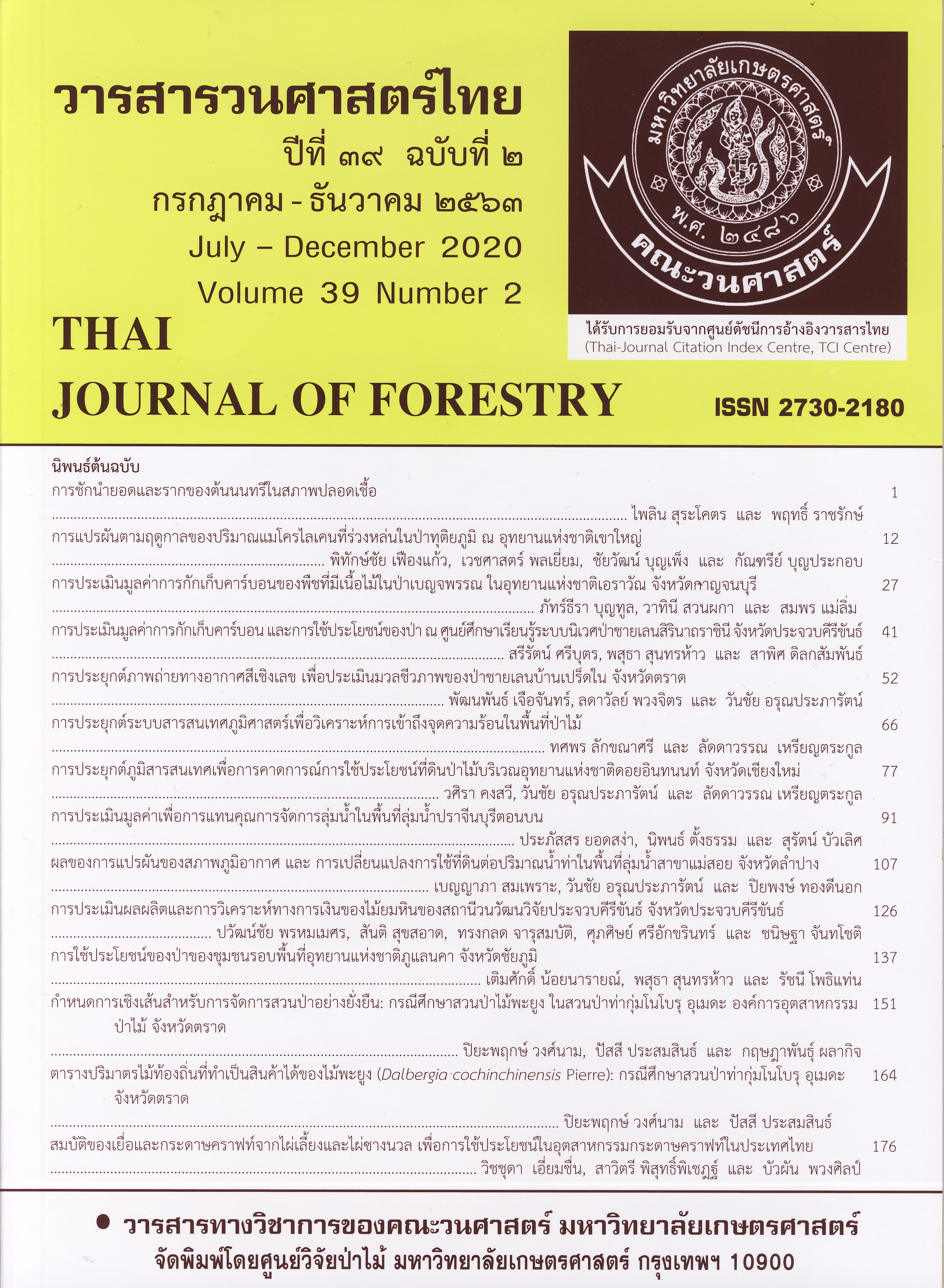สมบัติของเยื่อและกระดาษคราฟท์จากไผ่เลี้ยงและไผ่ซางนวล เพื่อการใช้ประโยชน์ในอุตสาหกรรมกระดาษคราฟท์ในประเทศไทย
Main Article Content
บทคัดย่อ
การศึกษาศักยภาพของเส้นใยไผ่ในประเทศไทย สำหรับการใช้ประโยชน์ในอุตสาหกรรมกระดาษคราฟท์ครั้งนี้ได้พิจารณาใช้ไผ่เลี้ยง (×Thyrsocalamus liang) และไผ่ซางนวล (Dendrocalamus membranaceus) เป็นวัตถุดิบในการผลิตเย่ื่อคราฟท์ไม่ฟอก โดยใช้แอคทีฟอัลคาไค (active alkali) ร้อยละ 24 ซัลฟิดิตี้ (sulfidity) ร้อยละ 35 เพื่อศึกษาผลผลิตเยื่อ ส่วนตกค้าง สมบัติด้านความแข็งแรง และเปรียบเทียบสมบัติของเยื่อคราฟท์ไม่ฟอกของไผ่ทั้ง 2 ชนิด เพื่อวิเคราะห์ศักยภาพในการนำไปใช้ประโยชน์ในอุตสาหกรรมกระดาษคราฟท์ จากผลการศึกษาพบว่า ไผ่ทั้ง 2 ชนิด ให้ผลผลิตเยื่อค่อนข้างสูง (ร้อยละ 47 และ 49) และส่วนตกค้างน้อย (ร้อยละ0.14 และ 0.33) ในขณะที่ตัวเลขคัปปา มีค่า 18 และ 24 และเมื่อนำเยื่อคราฟท์ไม่ฟอกของไผ่ทั้ง 2 ชนิดไปทำการบดเยื่อในช่วงเวลา 0 ถึง 45 นาที เตรียมแผ่นชิ้นตัวอย่างและทดสอบสมบัติความแข็งแรง พบว่า ดัชนีการต้านทานแรงดึง ดัชนีการต้านทานแรงดันทะลุ และ ความแข็งแรงต่อการหักพับมีแนวโน้มเพิ่มขึ้น เมื่อเวลาการบดเยื่อเพิ่มจาก 0 ถึง 45 นาที ในขณะที่ดัชนีการต้านทาน แรงฉีกขาดเพิ่มขึ้นสูงสุด ที่เวลาบดเยื่อ 15 นาที และลดลงเมื่อระยะเวลาบดเพิ่มขึ้น เยื่อคราฟท์ไม่ฟอกจากไผ่เลี้ยง มีแนวโน้มสามารถพัฒนาค่าความแข็งแรงให้ใกล้เคียงเยื่อคราฟท์ไม่ฟอกจากไม้ใบแคบได้ ดังนั้น ไผ่เลี้ยงจึงเป็นวัตถุดิบที่สามารถนำมาใช้ในอุตสาหกรรมเยื่อและกระดาษได้
Downloads
Article Details
ข้าพเจ้าและผู้เขียนร่วม (ถ้ามี) ขอรับรองว่า ต้นฉบับที่เสนอมานี้ยังไม่เคยได้รับการตีพิมพ์และไม่ได้อยู่ในระหว่างกระบวนการพิจารณาตีพิมพ์ลงในวารสารหรือสิ่งตีพิมพ์อื่นใด ข้าพเจ้าและผู้เขียนร่วม (ถ้ามี) ยอมรับหลักเกณฑ์และเงื่อนไขการพิจารณาต้นฉบับ ทั้งยินยอมให้กองบรรณาธิการมีสิทธิ์พิจารณาและตรวจแก้ต้นฉบับได้ตามที่เห็นสมควร พร้อมนี้ขอมอบลิขสิทธิ์ผลงานที่ได้รับการตีพิมพ์ให้แก่วารสารวนศาสตร์ คณะวนศาสตร์ มหาวิทยาลัยเกษตรศาสตร์ กรณีมีการฟ้องร้องเรื่องการละเมิดลิขสิทธิ์เกี่ยวกับภาพ กราฟ ข้อความส่วนใดส่วนหนึ่ง หรือ ข้อคิดเห็นที่ปรากฏในผลงาน ให้เป็นความรับผิดชอบของข้าพเจ้าและผู้เขียนร่วม (ถ้ามี) แต่เพียงฝ่ายเดียว และหากข้าพเจ้าและผู้เขียนร่วม (ถ้ามี) ประสงค์ถอนบทความในระหว่างกระบวนการพิจารณาของทางวารสาร ข้าพเจ้าและผู้เขียนร่วม (ถ้ามี) ยินดีรับผิดชอบค่าใช้จ่ายทั้งหมดที่เกิดขึ้นในกระบวนการพิจารณาบทความนั้น”
เอกสารอ้างอิง
Bubpha, A., S. Pisuttipiched and P. Somboon. 2016. Strength improvement of kraft linerboard by sweet bamboo pulp substitution for long fibers from softwood pulp. Thai Journal of Forestry 36(2): 98-106. (in Thai)
Gülsoy, S.K. and H. Eroğlu. 2010. Effects of sodium borohydride on biokraft pulping of European black pine (Pinus nigra Arn.). Technology 13(4): 245-250.
Kamthai, S. and P. Puthson. 2005. Effect of beating revolution on sweet bamboo (Dendrocalamus asper Backer) kraft pulp properties. Chiang Mai University Journal (Thailand) 4(2): 137-147.
Nitisoravut, N. and R.O. Malinen. 2007. Fiber morphology and papermaking properties of selected Thai bamboos, pp. 83-89. In 61st Appita Annual Conference and Exhibition. 7-10 May 2007. Appita, Australia.
Pisuttipiched, S. 2016. Bamboo fiber: The future of Thai long fiber, pp. 150-151. In P. Sunthornhao., ed. 8th Decades Forestry, Science of Life. Forestry Research Center, Kasetsart University, Bangkok. (in Thai)
Rahmati, H., P. Ebrahimi and M. Sedghi. 2010. Effect of cooking conditions and oxygen-delignification on Bambusa tulda kraft pulping. Indian Journal of Chemical Technology 17: 74-77.
Sangkaeo, S., A. Tirawatthananon and K. Jindawong. 2011. Bamboo of Thailand. Baanlaesuan, Bangkok. (in Thai)
The Thai Pulp and Paper Industries Association. 2020. TPPIA Directory 2020-2022. The Thai Pulp and Paper Industries Association, Bangkok.


